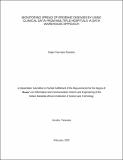| dc.contributor.author | Rutatola, Edger Pascrates | |
| dc.date.accessioned | 2020-09-17T12:19:47Z | |
| dc.date.available | 2020-09-17T12:19:47Z | |
| dc.date.issued | 2020-02 | |
| dc.identifier.uri | https://doi.org/10.58694/20.500.12479/905 | |
| dc.description | A Dissertation Submitted in Partial Fulfillment of the Requirements for the Degree of
Master’s in Information and Communication Science and Engineering of the
Nelson Mandela African Institution of Science and Technology | en_US |
| dc.description.abstract | Many countries apply data science techniques to enhance their health sectors and the
surveillance of diseases. The success of the innovations lies on the availability and quality of
datasets to be analyzed. In Tanzania, while different Hospital Management Information Systems
(HoMIS) like the Government of Tanzania Hospital Management Information System (GoTHoMIS)
are
installed
in
various
hospitals,
the
data
stored
in
the
systems
are
not
integrated.
This
causes
unavailability of high quality, timely, anonymous, harmonized, and integrated datasets
that can be shared and exhaustively analyzed for epidemic diseases surveillance. This study
intended to develop a data warehouse to host patients’ demographic and clinical particulars
essential for epidemic diseases surveillance from a multi-node GoT-HoMIS, and yield an
integrated dataset that can be used for epidemic diseases surveillance.
Interviews were conducted in three strategic health facilities and the Ministry responsible for
Health in Tanzania. Documents were reviewed, and observation done on the patient’s
registration process in the GoT-HoMIS. Thereafter, a data warehouse was developed to run
under MariaDB database server, and using Hypertext Preprocessor an Extract, Transform, and
Load (ETL) module was developed. The ETL module was deployed at six health facilities, and
the resulting integrated dataset of 152 104 facts was visualized by using FusionCharts libraries.
The study demonstrates a novel means to extract data straight from the GoT-HoMIS nodes,
which has the potential to make available and provide timely data and integrated reports for
decision-making on epidemics. By scaling the innovation to other health facilities, epidemics
surveillance can be significantly enhanced. | en_US |
| dc.language.iso | en | en_US |
| dc.publisher | NM-AIST | en_US |
| dc.rights | Attribution-NonCommercial-ShareAlike 4.0 International | * |
| dc.rights.uri | http://creativecommons.org/licenses/by-nc-sa/4.0/ | * |
| dc.subject | Research Subject Categories::TECHNOLOGY | en_US |
| dc.title | Monitoring spread of epidemic diseases by using clinical data from multiple hospitals: a data warehouse approach | en_US |
| dc.type | Thesis | en_US |


